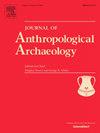实时文化差异的物质生产:德里分治难民中的旁遮普语,孟加拉语和nwfp
IF 2.2
1区 社会学
Q1 ANTHROPOLOGY
引用次数: 0
摘要
考古学家了解将文化类别视为物质文化使用和偏好的决定性因素的局限性。尽管如此,在试图解释与迁移时刻相关的物质模式时,避免这样的假设是具有挑战性的。本文考虑了1947年南亚分治后,区域身份如何塑造了德里(印度)难民与安置住房景观的互动方式。整理了现场调查、口述历史访谈和文献记录的信息后,我认为难民通常将他们在分割前的区域身份视为他们如何与城市景观互动的主要导向因素。旁遮普难民自我描述他们的安置空间是现代和快速变化的。孟加拉难民强调他们社区的绿地和节日场地。来自西北边境普罗旺斯的难民强调了他们面对强制性政府计划的韧性。所有人都认为,突出这些身份是对抗与更广泛的“难民”标识符相关的负面刻板印象的手段。本案例研究强调了个人如何为文化身份决定论和相关物质能指的主导叙事做出贡献。本文章由计算机程序翻译,如有差异,请以英文原文为准。
The material production of cultural difference in real time: Punjabi, Bengali, and NWFP-ness among Partition refugees in Delhi
Archaeologists understand the limitations of viewing cultural categories as deterministic of material culture use and preference. Nonetheless, it is challenging to avoid such assumptions when attempting to interpret material patterns associated with moments of migration. This paper considers how regional identities shaped the ways refugees interacted with resettlement housing landscapes in Delhi (India) following the 1947 Partition of South Asia. Collating information from in-site survey, oral history interviews, and documentary records, I argue that refugees often view their prePartition regional identities as a major orienting factor in how they have interacted with urban landscapes in the city. Punjabi refugees self-describe their resettlement spaces as modern and quick-changing. Bengali refugees highlight the green space and festival grounds in their communities. Refugees from the North West Frontier Provence highlight their resilience in the face of coercive government planning. All view foregrounding such identities as means to counter the negative stereotypes associated with the broader identifier “refugee.” This case study highlights how individuals can themselves contribute to dominant narratives about the determinism of cultural identities and associated material signifiers.
求助全文
通过发布文献求助,成功后即可免费获取论文全文。
去求助
来源期刊

Journal of Anthropological Archaeology
Multiple-
CiteScore
4.00
自引率
11.10%
发文量
64
期刊介绍:
An innovative, international publication, the Journal of Anthropological Archaeology is devoted to the development of theory and, in a broad sense, methodology for the systematic and rigorous understanding of the organization, operation, and evolution of human societies. The discipline served by the journal is characterized by its goals and approach, not by geographical or temporal bounds. The data utilized or treated range from the earliest archaeological evidence for the emergence of human culture to historically documented societies and the contemporary observations of the ethnographer, ethnoarchaeologist, sociologist, or geographer. These subjects appear in the journal as examples of cultural organization, operation, and evolution, not as specific historical phenomena.
 求助内容:
求助内容: 应助结果提醒方式:
应助结果提醒方式:


